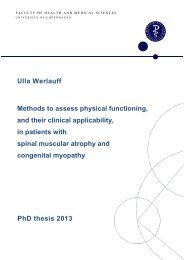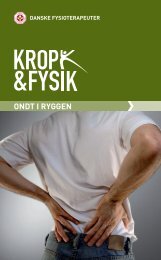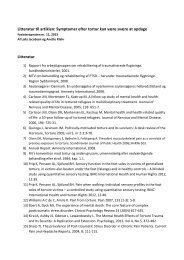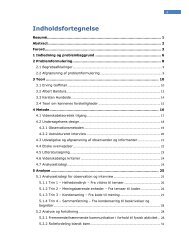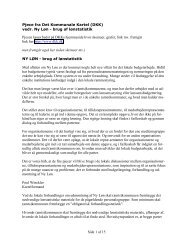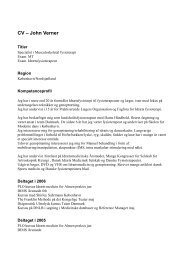Kristian Thorborg's Phd Thesis
Kristian Thorborg's Phd Thesis
Kristian Thorborg's Phd Thesis
Create successful ePaper yourself
Turn your PDF publications into a flip-book with our unique Google optimized e-Paper software.
Strength data obtained by HHD can be used clinically in different ways. One possibility is to use<br />
normative values. However, normative values do often not exist for different age groups and<br />
levels of physical activity, and is therefore typically not an option. Another possibility is to use the<br />
unaffected limb as a control. A lower limb symmetry index (LSI) can then be calculated by dividing<br />
the strength of the affected limb by the unaffected limb.[76] Generally, it has been suggested that<br />
lower-extremity strength deficits of less than 10% on the injured side compared to the uninjured<br />
side should be considered the clinical milestone before returning an athlete to sport following an<br />
injury.[76,77] More specifically, the achievement of a hip ADD/ABD ratio of more than 90% and an<br />
hip ADD strength equal to that of the contralateral side has been recommended before returning<br />
to sport after an adductor strain.[78] However, Thorborg et al.[70] showed, that eccentric hip ADD<br />
symmetry cannot be assumed in injury-free soccer players. In fact, the dominant side was 14%<br />
stronger than the non-dominant side with regards to eccentric hip ADD strength, although hip ABD<br />
strength was similar. This finding of asymmetric eccentric hip ADD strength in injury-free soccer<br />
players, between the dominant and non-dominant leg,[70] indicates that using contralateral<br />
eccentric hip ADD strength as a reference-point for muscle recovery may be questionable.<br />
Strength ratios, such as the hip ADD/ABD strength ratio, have previously been used for research<br />
purposes, and seem to be a relevant measure of hip strength,[48] especially in athletes with<br />
bilateral groin symptoms, where the contralateral limb cannot be used as a reference point. For<br />
clinical evaluation of the individual athlete, the obvious advantage is that this testing method does<br />
not require any age, limb-length or weight adjustment, since the player can act as his own control.<br />
This makes the testing method ideal for quick assessments in the busy clinical situation. However,<br />
the reliability of such ratio’s are often not reported. Just as with the LSI, a ratio is the result of two<br />
tests, including the individual measurement variation of each test. These measures are therefore<br />
often less reliable, compared to one test or movement direction, and measurement variation is<br />
increased.<br />
Patient-reported outcome questionnaires<br />
There is a general consensus that Patient-Reported Outcomes (PROs) should serve as the gold<br />
standard in the assessment of musculoskeletal conditions, where the patient’s perspective and<br />
health-related quality of life are of primary interest.[4,79-81] A PRO is any report coming directly<br />
19



